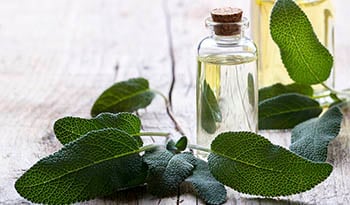3 Reasons Why You May Have Seen Eucalyptus Plants Hanging in the Shower
DISCLAIMER:This blog does not intend to provide diagnosis...
- In this article:
- What is Eucalyptus Oil Used For?
- Eucalyptus Oil and Respiratory Conditions
- Antimicrobial Effects of Eucalyptus Oil
- Insect Repellant
- Safety
- Takeaway

What is Eucalyptus Oil Used For?
Eucalyptus essential oil is an ancient remedy used historically for lung conditions and its antimicrobial benefits. The oil is derived from eucalyptus leaves that are steam distilled. Similar to the leaves, the oil has a strong, fresh scent that is quite distinct. The essential oil can be derived from different eucalyptus species, each with somewhat different effects.
The main constituent found in most eucalyptus oils is eucalyptol (1,8-cineole) with levels that can vary from 45–77% or more. Eucalyptus essential oil is commonly encountered in vapor rubs used for chest and sinus congestion. As with many folk remedies, the latest research is starting to support its historical uses.
Eucalyptus Oil and Respiratory Conditions
When most people think of eucalyptus oil, they likely think of inhaling the oil to help with sinus and chest congestion. The main constituent in the oil, eucalyptol, has mucolytic properties. In plain terms, it helps decrease mucus. Research has shown that eucalyptol significantly reduces the expression of two genes involved with mucus production.
Beyond mucolytic effects, eucalyptol also relaxes smooth muscle present along the airways. This opens up the lungs wider, helping decrease congestion and making it easier to breathe. In combination with these effects, the oil also displays strong anti-inflammatory activity, which further helps round out its benefits for respiratory conditions. Most of the studies on its respiratory benefits have used pure eucalyptol in capsules taken orally.
Antimicrobial Effects of Eucalyptus Oil
Eucalyptus has well-known antimicrobial effects, although, again, with significant differences among eucalyptus species. In some cases, the oil has proven effective for killing fungus, bacteria, and parasites along with having potential antiviral effects.
Fungus
When compared to a standard antifungal drug, eucalyptus essential oil had similar effects against candida species found in the mouth. Based on the results, the authors concluded that diluted eucalyptus oil could be useful for helping maintain oral hygiene. For years, eucalyptus has been a common component of several different natural mouthwash-based products.
Bacteria
Due to the overuse of antibiotics, bacteria are becoming increasingly resistant to standard antimicrobial treatments. Several bacteria are well known for their resistance, including Staphylococcus aureus and Mycobacterium tuberculosis. One recent study found that eucalyptus essential oil has promising effects against most strains of methicillin-resistant Staphylococcus aureus (MRSA) bacteria. Other studies have found similar results.
Roughly about one-quarter of people worldwide are infected with the bacterium that causes tuberculosis. A subset of these individuals will develop tuberculosis, a lung infection that can be fatal. Tuberculosis is caused by mycobacterial infections, including Mycobacterium tuberculosis. One study found eucalyptus essential oil to be a promising potential treatment that completely inhibited mycobacterial growth of multidrug-resistant mycobacteria at a 1% dilution.
Parasites
Echinococcus is a type of tapeworm found in animals that can infect humans. In a study on tapeworm larva from sheep, a 1% eucalyptus solution killed 100% of larva within one minute of exposure, similar to the standard drugs povidone-iodine and silver nitrate.
Head lice is another type of parasitic infection common in children. Standard treatments use a neurotoxic pesticide, permethrin, although data suggest eucalyptus oil may be an option. Lice eggs exposed to 10% eucalyptus oil for five minutes were effectively killed. A 10-minute exposure to permethrin still had a 95% hatch rate. Ginger essential oil showed similar results. When combined with eucalyptus, the combination was found to be even more effective.
Insect Repellant
Some species of eucalyptus, especially lemon eucalyptus, have shown promising results as natural insect repellents. Lemon eucalyptus essential oil has a distinct lemon-like odor. In a listing of effective insect repellents, even the Environmental Protection Agency includes lemon eucalyptus oil. Unlike normal eucalyptus, lemon eucalyptus is high in a compound called citronellal.
Studies of natural chemical compounds effective as insect repellants include common constituents from a number of essential oils, including limonene, eucalyptol, geraniol, eugenol, and citronellal. Limonene is found in citrus essential oils like orange, lemon, and lime. Eucalyptol is found in eucalyptus. Geraniol is found in rose oil, palmarosa, and citronella oils. Eugenol comes primarily from cloves essential oil. And citronellal is found in lemon eucalyptus and citronella essential oils. Combinations of essential oils appear promising as a natural approach to keeping bugs at bay.
While only relevant in South and Central America, eucalyptol does attract some species of orchid bee which can sting. However, the bees are considered less dangerous than honeybees and are not found in other locations.
Safety
Many of the studies exploring the effects of eucalyptus essential oils used a purified form of eucalyptol that was taken orally. Essential oils contain potent, natural chemicals, and adulteration is not uncommon with some commercial products. Recent estimates suggest that up to 80% of commercially available essential oils may be adulterated in some way.
Oral use of essential oils should only be attempted under the recommendation of a knowledgeable healthcare provider to ensure safety and proper dosing. For medicinal use of essential oils, independent lab analysis confirming a pure product is also important.
Takeaway
The research on eucalyptus essential oil and its constituents appears to indicate promising activity for helping treat respiratory illnesses. Eucalyptus also appears to have antimicrobial effects on a broad array of organisms, including certain bacteria, fungi, and parasites along with antiviral effects. Formulations using essential oils as bug repellants also show promise, including specifically lemon eucalyptus.
References:
- Aldoghaim FS, Flematti GR, Hammer KA. Antimicrobial Activity of Several Cineole-Rich Western Australian Eucalyptus Essential Oils. Microorganisms. 2018;6(4):122. Published 2018 Dec 3. doi:10.3390/microorganisms6040122
- Tyagi AK, Malik A. Antimicrobial Potential and Chemical Composition of Eucalyptus globulus Oil in Liquid and Vapour Phase Against Food Spoilage Organisms. Food Chem. 2011;126(1):228-235.
- Sudhoff H, Klenke C, Greiner JF, et al. 1,8-Cineol Reduces Mucus-Production in a Novel Human Ex Vivo Model of Late Rhinosinusitis. PLoS One. 2015;10(7):e0133040. Published 2015 Jul 24. doi:10.1371/journal.pone.0133040
- Nascimento NR, Refosco RM, Vasconcelos EC, et al. 1,8-Cineole induces relaxation in rat and guinea-pig airway smooth muscle. J Pharm Pharmacol. 2009;61(3):361-366. doi:10.1211/jpp/61.03.0011
- Juergens UR. Anti-inflammatory properties of the monoterpene 1.8-cineole: current evidence for co-medication in inflammatory airway diseases. Drug Res (Stuttg). 2014;64(12):638-646. doi:10.1055/s-0034-1372609
- Fischer J, Dethlefsen U. Efficacy of cineole in patients suffering from acute bronchitis: a placebo-controlled double-blind trial. Cough. 2013;9(1):25. Published 2013 Nov 21. doi:10.1186/1745-9974-9-25
- Tesche S, Metternich F, Sonnemann U, Engelke JC, Dethlefsen U. The value of herbal medicines in the treatment of acute non-purulent rhinosinusitis. Results of a double-blind, randomised, controlled trial. Eur Arch Otorhinolaryngol. 2008;265(11):1355-1359. doi:10.1007/s00405-008-0683-z
- Worth H, Schacher C, Dethlefsen U. Concomitant therapy with Cineole (Eucalyptole) reduces exacerbations in COPD: a placebo-controlled double-blind trial. Respir Res. 2009;10(1):69. Published 2009 Jul 22. doi:10.1186/1465-9921-10-69
- Koshak A, Wei L, Koshak E, et al. Nigella sativa Supplementation Improves Asthma Control and Biomarkers: A Randomized, Double-Blind, Placebo-Controlled Trial. Phytother Res. 2017;31(3):403-409. doi:10.1002/ptr.5761
- Gupta I, Gupta V, Parihar A, et al. Effects of Boswellia serrata gum resin in patients with bronchial asthma: results of a double-blind, placebo-controlled, 6-week clinical study. Eur J Med Res. 1998;3(11):511-514.
- Juergens UR, Dethlefsen U, Steinkamp G, Gillissen A, Repges R, Vetter H. Anti-inflammatory activity of 1.8-cineol (eucalyptol) in bronchial asthma: a double-blind placebo-controlled trial. Respir Med. 2003;97(3):250-256. doi:10.1053/rmed.2003.1432
- Worth H, Dethlefsen U. Patients with asthma benefit from concomitant therapy with cineole: a placebo-controlled, double-blind trial. J Asthma. 2012;49(8):849-853. doi:10.3109/02770903.2012.717657
- Noumi E, Snoussi M, Hajlaoui H, Trabelsi N, Ksouri R, Valentin E, Bakhrouf A.Chemical composition, antioxidant and antifungal potential of Melaleuca alternifolia (tea tree) and Eucalyptus globulus essential oils against oral Candida species. J Med Plant Res. 2011;5(17):4147-4156.
- Elaissi A, Rouis Z, Salem NA, et al. Chemical composition of 8 eucalyptus species' essential oils and the evaluation of their antibacterial, antifungal and antiviral activities. BMC Complement Altern Med. 2012;12:81. Published 2012 Jun 28. doi:10.1186/1472-6882-12-81
- Iseppi R, Mariani M, Condò C, Sabia C, Messi P. Essential Oils: A Natural Weapon against Antibiotic-Resistant Bacteria Responsible for Nosocomial Infections. Antibiotics (Basel). 2021;10(4):417. Published 2021 Apr 10. doi:10.3390/antibiotics10040417
- Tohidpour A, Sattari M, Omidbaigi R, Yadegar A, Nazemi J. Antibacterial effect of essential oils from two medicinal plants against Methicillin-resistant Staphylococcus aureus (MRSA). Phytomedicine. 2010;17(2):142-145. doi:10.1016/j.phymed.2009.05.007
- Merghni A, Noumi E, Hadded O, et al. Assessment of the antibiofilm and antiquorum sensing activities of Eucalyptus globulus essential oil and its main component 1,8-cineole against methicillin-resistant Staphylococcus aureus strains. Microb Pathog. 2018;118:74-80. doi:10.1016/j.micpath.2018.03.006
- El Omari K, Hamze M, Alwan S, Osman M, Jama C, Chihib NE. In-vitro evaluation of the antibacterial activity of the essential oils of Micromeria barbata, Eucalyptus globulus and Juniperus excelsa against strains of Mycobacterium tuberculosis (including MDR), Mycobacterium kansasii and Mycobacterium gordonae. J Infect Public Health. 2019;12(5):615-618. doi:10.1016/j.jiph.2019.01.058
- Schnitzler P, Schön K, Reichling J. Antiviral activity of Australian tea tree oil and eucalyptus oil against herpes simplex virus in cell culture. Pharmazie. 2001;56(4):343-347.
- Panikar S, Shoba G, Arun M, et al. Essential oils as an effective alternative for the treatment of COVID-19: Molecular interaction analysis of protease (Mpro) with pharmacokinetics and toxicological properties. J Infect Public Health. 2021;14(5):601-610. doi:10.1016/j.jiph.2020.12.037
- Moazeni M, Hosseini SV, Al-Qanbar MH, Alavi AM, Khazraei H. In vitro evaluation of the protoscolicidal effect of Eucalyptus globulus essential oil on protoscolices of hydatid cyst compared with hypertonic saline, povidone iodine and silver nitrate. J Visc Surg. 2019;156(4):291-295. doi:10.1016/j.jviscsurg.2019.01.002
- Soonwera M, Wongnet O, Sittichok S. Ovicidal effect of essential oils from Zingiberaceae plants and Eucalytus globulus on eggs of head lice, Pediculus humanus capitis De Geer. Phytomedicine. 2018;47:93-104. doi:10.1016/j.phymed.2018.04.050
- CDC. Avoid Bug Bites. Centers for Disease Control and Prevention. Update May 6, 2021. Accessed August 30, 2021. https://wwwnc.cdc.gov/travel/page/avoid-bug-bites#repellent
- da Silva MRM, Ricci-Júnior E. An approach to natural insect repellent formulations: from basic research to technological development. Acta Trop. 2020;212:105419. doi:10.1016/j.actatropica.2020.105419
- Satyal P, Setzer WN. Adulteration Analysis in Essential Oils. In: Malik S (eds) Essential Oil Research. Springer, Cham. 2009:261-273. https://doi.org/10.1007/978-3-030-16546-8_9
- Schiestl FP, Roubik DW. Odor compound detection in male euglossine bees. J Chem Ecol. 2003;29(1):253-257. doi:10.1023/a:1021932131526

 By Dr. Scott Buesing, N.D.
By Dr. Scott Buesing, N.D.


